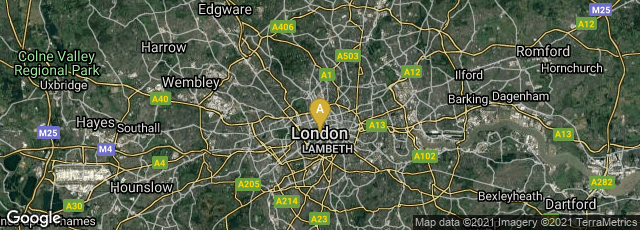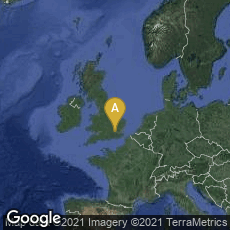

A: London, England, United Kingdom
"English book owners in the seventeenth century
A work in progress listing
"How much do we really know about patterns and impacts of book ownership in Britain in the seventeenth century? How well equipped are we to answer questions such as the following?:
What was a typical private library, in terms of size and content, in the seventeenth century?
How does the answer to that question vary according to occupation, social status, etc?
How does the answer vary over time? – how different are ownership patterns in the middle of the century from those of the beginning, and how different are they again at the end?
"Having sound answers to these questions will contribute significantly tour understanding of print culture and the history of the book more widely during this period.
"Our current state of knowledge is both imperfect, and fragmented. There is no directory or comprehensive reference source on seventeenth-century British book owners, although there are numerous studies of individual collectors. There are well-known names who are regularly cited in this context – Cotton, Dering, Pepys – and accepted wisdom as to collections which were particularly interesting or outstanding, but there is much in this area that deserves to be challenged. Private Libraries in Renaissance England and Books in Cambridge Inventories have developed a more comprehensive approach to a particular (academic) kind of owner, but they are largely focused on the sixteenth century. Sears Jayne, Library Catalogues of the English Renaissance, extends coverage to 1640, based on book lists found in a variety of manuscript sources. The Cambridge History of Libraries in Britain and Ireland (2006) contains much relevant information in this field, summarising existing scholarship, and references to this have been included in individual entries below where appropriate.
"Evidence of book ownership in this period is manifested in a variety of ways, which need to be brought together if we are to develop that fuller picture. Lists of books once owned by particular people can be found in sale catalogues, private catalogues, wills, and other various
kinds of inventory. Many collections for which no such lists exist are witnessed to today by surviving books, with inscriptions, bookplates, armorial bindings, and numerous other kinds of copy-specific markings. Some collections survive entire, where they were bequeathed or
bought en bloc, while others were scattered and are much harder to reconstruct. Working from surviving books is bedevilled not only by the fact that owners did not always mark their books, but also by needing to remember that vast quantities of books have been destroyed
since the seventeenth century. There are many collections which once existed which we will never be able to recognise. The quantity of material in our libraries today is nevertheless sufficient to allow us to make significant advances in our knowledge of early book ownership,
if we can bring together that information.
"This list represents work in progress to construct a reference source on seventeenth-century English book owners, based on all these various kinds of evidence. It does not seek to cover Scottish and Irish owners, unless they were predominantly English-based. The aim is to focus
on collections which were at least partly, if not entirely, formed within the seventeenth century and the list includes people who died between 1610 and 1715.
"The list draws largely on existing published work but also incorporates evidence of surviving books, taken mainly from sale and library catalogues. One of the challenges of this exercise lies in establishing criteria for inclusion, as regards size of collection. Is a private library of
this period interesting if it contains 50 books, 100 books, or 500 books? There is no simple answer to this; it depends on who the owner was, what the books were, and which part of the century it applies to. The list has been compiled on an essentially intuitive basis with the aim
of including people who did, or are likely to have, owned enough books to be worth noting in the context of developing that wider understanding. Refining and developing the list is part of the research process. We cannot list every individual who owned a Bible and a shelf of
devotional books, but a grocer who owned 50 books in 1620 may be at least as interesting as an academic who owned 500. The list does not include people who are likely to have been owners, but for whom there is no surviving evidence. A number of known users of armorial
binding stamps are included, together with users of bookplates, found the Franks collection, and known to have died before 1715 (these are both areas where other projects and and directories are being worked on).
"The arrangement of the list should be self-evident, alphabetical by owners’ names, with some entries relating to families rather than individuals (this, again, is an area where more thought is needed as to how best to cope with collections built up over more than one generation). The references cited are not meant to be exhaustive; abbreviated references are expanded in the list at the end.
"One of the ways in which an online resource like this can be useful is by providing quick links to images of the kinds of provenance evidence which various owners left in their books, so that identifications can be verified (is this inscription I’m looking at the man I think it is, or another owner of the same name? etc). I have been gradually adding links to other websites which include useful images like this. One of the features of this latest version of the list is the addition of links to a number of other images of inscriptions and bookplates, which I have put onto Flickr. I will aim to augment this over time. The list also now includes links to the
database of British Armorial Bindings, begun by John Morris and completed by Philip Oldfield, and freely available on the web via the University of Toronto and the sponsorship of the Bibliographical Society. This major reference work contains details and images of all
known armorial binding stamps used by British owners not only in the seventeenth century, but from the earliest use of suecvh stamps in the sixteenth century through to the present day.
"I am sharing this list through bibliographical Internet sites partly because, imperfect and incomplete though it is, the list may already have enough data to be useful in various kinds of ways, and partly in the hope of stimulating responses and ideas as to how it should be developed. It may also be useful as a list of references and sources of further leads on particular owners. I will be very glad to have suggestions for names and references which should be added, or any other feedback from others who are interested in this area of book history as to how to take this project forward (many thanks to everyone who has already contacted me in this way, including Bob Fehrenbach, Peter Hoare, Philip Oldfield, Jeremy Potter, Renae Satterley and David Shaw). I am happy for any or all of the data here to beused in any ways that are helpful to fellow book historians though I would appreciate the source being cited where appropriate.
"David Pearson
Revised December 2013
Email [email protected]" (The Bibliographical Society Electronic Publications 2007 [latest version December 2013], accessed 11-30-2014)
In November 2014 Mr. Pearson's bibliographical listing, including many links to other websites, was available from The Bibliographical Society at this link.